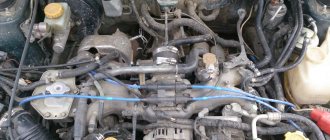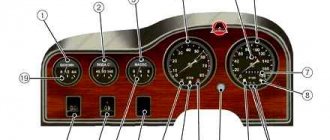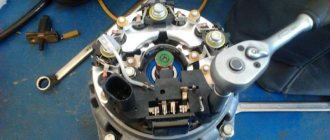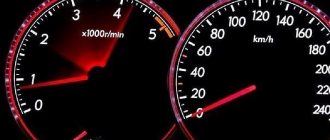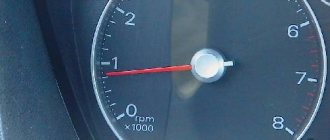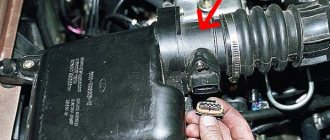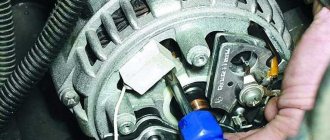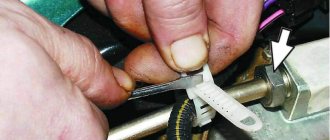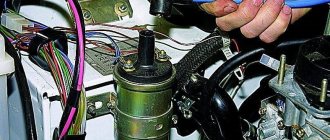In reality, it often happens that a VAZ-2110, after a certain period of active operation, begins to stall after starting the power plant. Car owners often also complain that the engine turns off at low speed.
It is worth noting, in fairness, that such problems occur not only in products of the domestic automotive industry, but also in foreign cars. However, few drivers know the reasons for such a breakdown. Therefore, it is extremely important to understand how to cope with trouble without turning to a car service unless absolutely necessary - this will save a lot of money and nerves.
Those who forget about the existing problem immediately after the car starts working are completely wrong. Such drivers are confident that if the engine has started and is functioning stably, then there is no need to worry. However, in reality there was no repair of the breakdown, which means that in the future the situation will repeat itself again. Thus, we strongly recommend that in the event of the first incident, the malfunction is eliminated as soon as possible. This approach will definitely pay off in the long run.
Problem with the injector: features
Most modern cars have a forced fuel injection system. Therefore, such a situation when a car stalls while driving is quite common and can be caused by the erroneous use of an injection engine. There is no need to disconnect the battery while the engine is still running. You should resort to using a cigarette lighter in the most extreme cases, minimizing its use if possible.
If the car in the circuit has a neutralizer, then when trying to start the vehicle it is better to avoid towing or driving downhill. This results in the formation of fuel that has not been used, and this can lead to spontaneous combustion if it enters the converter. Avoid getting water into the engine. To do this, you should promptly replace fuel filters and fill in high-quality gasoline.
In general, it is better to exercise extreme caution with the power system. Such actions can have a detrimental effect on the sensitive injector.
If possible, it is better to leave the mass on. Otherwise, the data on your computer may be lost. It is advisable to let the engine run for about three minutes at idle speed. If charging and starting devices are used with the injector, the electronic control unit may burn out.
Motorhelp.ru engine diagnostics and repair
Typical operating parameters of VAZ injection engines.
For many novice diagnosticians and ordinary car enthusiasts who are interested in the topic of diagnostics, information about typical engine parameters will be useful. Since VAZ car engines are the most common and easiest to repair, we’ll start with them
What should you pay attention to first when analyzing engine operating parameters?1. Engine stopped.1.1 Coolant and air temperature sensors (if equipped)
The temperature is checked to ensure that the readings correspond to the actual engine and air temperatures. It is better to check using a non-contact thermometer. By the way, one of the most reliable in the injection system of VAZ engines are temperature sensors.
1.2 Throttle position (except for systems with an electronic gas pedal). The gas pedal is released - 0%, the accelerator is pressed - according to the opening of the throttle valve. We played with the gas pedal, released it - it should also remain 0%, while the ADC with a dpdz of about 0.5V. If the opening angle jumps from 0 to 1-2%, then as a rule this is a sign of a worn out valve. Less common are faults in the sensor wiring. With the gas pedal fully pressed, some units will show 100% opening (such as January 5.1, January 7.2), while others such as Bosch MP 7.0 will show only 75%. This is fine.
1.3 MAF ADC channel in rest mode: 0.996/1.016 V - normal, up to 1.035 V is still acceptable, everything above is already a reason to think about replacing the mass air flow sensor. Injection systems equipped with feedback from an oxygen sensor are able to correct, to some extent, incorrect readings of the mass air flow sensor, but there is a limit to everything, so you should not delay replacing this sensor if it is already worn out.
2. The engine is idling.
2.1 Idle speed. Typically this is 800 - 850 rpm with a fully warmed up engine. The idle speed value depends on the engine temperature and is set in the engine control program.
2.2 Mass air flow. For 8-valve engines, the typical value is 8-10 kg/h, for 16-valve engines - 7-9.5 kg/h with a fully warmed-up engine at idle. For the M73 ECU these values are slightly higher due to a design feature.
2.3 Length of injection time. For phased injection, the typical value is 3.3 - 4.1 ms. For simultaneous – 2.1 – 2.4 ms
Actually, the injection time itself is not as important as its correction
2.4 Injection time correction factor. Depends on many factors. This is a topic for a separate article, but it’s worth mentioning here that the closer to 1,000 the better. More than 1,000 means the mixture is further enriched, less than 1,000 means it is leaner.
2.5 Multiplicative and additive components of self-learning correction. A typical multiplicative value is 1 +/-0.2. The additive is measured as a percentage and should be no more than +/- 5% on a working system.
2.6 If there is a sign of engine operation in the adjustment zone, based on the signal from the oxygen sensor, the latter should draw a beautiful sinusoid from 0.1 to 0.8 V.
2.7 Cyclic filling and load factor. For “January” typical cyclic air consumption: 8 valve engine 90 - 100 mg/stroke, 16 valve engine 75 -90 mg/stroke. For Bosch 7.9.7 control units the typical load factor is 18 – 24%.
Now let's take a closer look at how these parameters behave in practice. Since I use the SMS Diagnostics program for diagnostics (hi to Alexey Mikheenkov and Sergey Sapelin!), all the screenshots will be from there. The parameters were taken from practically serviceable cars, with the exception of specially stated cases. All images are clickable.
VAZ 2110 8-valve engine, control unit January 5.1 Here the CO correction coefficient has been slightly adjusted due to slight wear of the mass air flow sensor.
VAZ 2107, control unit January 5.1.3
VAZ 2115 8 valve engine, control unit January 7.2
Engine VAZ 21124, control unit January 7.2
VAZ 2114 8 valve engine, Bosch control unit 7.9.7
Priora, VAZ 21126 1.6 l engine, Bosch control unit 7.9.7
Zhiguli VAZ 2107, control unit M73
Engine VAZ 21124, control unit M73
VAZ 2114 8 valve engine, M73 control unit
Kalina, 8 valve engine, M74 control unit
Niva VAZ-21214 engine, Bosch ME17.9.7 control unit
And in conclusion, let me remind you that the above screenshots were taken from real cars, but unfortunately the recorded parameters are not ideal. Although I tried to record parameters only from working cars. download dle 10.6 movies for free
Source
Injector malfunction
The next reason that the engine starts and immediately stalls is a malfunction of the injector. Since most modern cars have a forced fuel injection system, this malfunction is very common.
Don't make mistakes.
What should not be allowed when operating fuel-injected cars:
- Do not disconnect the battery while the engine is running.
- Try to play with lighting as little as possible, and in general, handle food as carefully as possible. Injection cars are very sensitive to such manipulations.
- Try not to disconnect the ground on the car. Although I turn off the mains in my car in winter if I don’t drive for a long time, and so far I have not noticed any discomfort in operation, although many experts say that it is possible to erase information in the computer. I just try to let the car idle for up to 3 minutes when starting the engine.
- Injector-injected cars are not very fond of charging and starting devices, since when they are used, the voltage jumps significantly and the ECU can burn out.
- If a neutralizer is provided in the design of the car, then try not to start the car by towing or pushing it down a hill, as unburned fuel is formed, which, if it gets into the neutralizer, can ignite spontaneously.
- Do not allow water to enter the injector; this is strictly contraindicated. To do this, change fuel filters in a timely manner and fill with high-quality gasoline.
What does a neutralizer look like?
If your car is equipped with an L probe and a neutralizer, then think about whether you should take the risk by using leaded gasoline. When using such gasoline, the L-probe, in addition to the fact that it itself can quickly break down, it will transmit incorrect data to the ECU, indicating a large amount of oxygen, and this, to put it mildly, is not very good, as it can lead to local overheating of the engine .
So, we return again to our problem, the engine starts and immediately stalls or does not start at all.
GOOD TIPS
First, let's look at the reasons common to carburetor and injection fuel supply. That is, reasons beyond their control. Anyone who has looked for the causes of problems themselves knows that this is done by the method of elimination. But the law of meanness always works, and the reason is, as a rule, in the last node being checked. Therefore, let's turn to statistics and, based on its prompting, begin to implement the random method.
- If the car runs on a 16-valve injector and stalls, then you need to change the oxygen sensor; it is possible that it is not tightly connected to the connector located on the air filter housing. You should connect it correctly, if this does not help, then you should clean the injectors, since the gasoline now contains impurities, and the injectors become clogged.
- The reason that the engine stalls while driving may be the idle speed sensor (IAC), or more precisely, the idle speed controller (IAC). By the way, if there are problems with the IAC, the engine stalls even at idle. So, you should remove it and start by simply cleaning it. Don't forget to clean the mounting hole on the throttle assembly where the sensor needle goes. After cleaning, you need to check its serviceability. To do this, with the ignition on, bring the power block to the removed sensor; if the conical needle extends, then everything is in order with the sensor, but if not, then the sensor needs to be changed.
- The reason that the car stalled while driving may be due to wear on the rollers or timing belt. In both cases, you need to contact a specialist. This is a serious knot. Giving absentee advice regarding the repair of this unit is, to say the least, irresponsible.
- When you start the car when it's hot, the engine stalls. The crankshaft sensor may need to be replaced. It is possible that the catalyst burned out and a plug formed in the exhaust system.
The list of supposed reasons can be continued indefinitely and one cannot find a reason why the VAZ-2110 stalls while driving, regardless of whether the injector supplies fuel or the carburetor. But this is not a reason to give up. The road can be mastered by anyone walking or driving, you just need to fix the problems in the car. We can say for sure that what will not help you start the engine is kicking innocent wheels and calling the car’s mother an unkind word. Remember, he doesn’t have a mother, he’s half orphan. Please be understanding about this.
There is a special offer on our website. You can get a free consultation with our corporate lawyer by simply submitting your question in the form below.
Didn't find the information you are looking for? on our forum.
If you find an error, please select a piece of text and press Ctrl+Enter.
We recommend reading:
How to raise the front pressure in the cooling system on a VAZ 2110 VAZ How to adjust the steering wheel on a VAZ 2114 Adjusting the rear axle gearbox of a VAZ 2106 at home Replacing the CV joint on VAZ cars with your own hands How to install a pump on a VAZ 2114. Replacing it yourself A VAZ 2114 stalls after releasing the gas Why the cylinder does not work on a VAZ 2105
Checking the idle air control
One of the reasons that the car stalls at low speeds is a malfunction of the idle air control (IAC). It should be tested to either rule out this cause or troubleshoot. There are several ways to check the serviceability of the IAC on the VAZ-2110:
- With the ignition off, connect the multimeter probes to the power supply. When they are connected, turn on the ignition and check the integrity of the winding and the power supply circuit in the following order: first, the probes are connected to pins 1 and 2. When the IAC is working properly, readings from 50 to 80 ohms appear on the multimeter sensor. When testing the 2nd and 3rd pins, as well as the 1st and 4th pins, there should be indicators indicating an infinite value.
- Visual inspection method. It is necessary to remove the regulator, disassemble it and determine the degree of coking, the degree of wear of the spring and other elements of the regulator. It is quite easy to visually determine that the regulator is simply time to change.
- It is still possible to carry out diagnostics using special testers, but purchasing such a tester will cost much more than replacing the part itself. It's up to you to decide whether it's worth purchasing such a device.
Spark plug
To make sure the spark plugs are working properly, you need to unscrew them all, check the gap size, as well as the presence of carbon deposits. And your car stalls while driving. The reason may be hidden in the candles. If there is heavy carbon deposits, but the gap is within acceptable values, it is necessary to clean the spark plug electrodes. But the best way out is to install new spark plugs. In the same case, if the gap is very large, there is excessive wear of the electrode, cleaning will not help, it is necessary to completely replace the set of spark plugs.
When a VAZ 2110 car starts and then stalls: our actions
Quite often during the operation of a car, a problem occurs when the VAZ 2110 starts and stalls almost instantly, and sometimes the engine stops working even at low speeds. This problem, of course, is faced not only by owners of domestic cars, but also of foreign cars. Any model is susceptible to this.
Many drivers do not know how to act in such a situation and begin to panic, feeling helpless. There is no need to senselessly pull on wires and pipes, much less kick the wheel. Such actions will definitely not help in determining the cause of the malfunction and eliminating it.
Another situation arises when the majority of car owners calm down if the car still starts after some time, and considers: the car started - that means everything is in order! But the problem remains, it has not been solved, and a similar situation is repeated. And again panic begins, to which is added indignation due to the fact that the malfunction was not eliminated at the very first occurrence of a similar picture.
The reasons that a car stalls at idle immediately after starting are different, and they most often depend on the model or generation of different brands of cars. This could be a clogged valve in the gas distribution system, or burnt relay contacts in the fuel pump.
Some car enthusiasts are able to carry out simple work to identify the problem and fix it later. For those who do not belong to this category, it is recommended to go to a car service center or call a tow truck if you still cannot start.
Reasons why a car won't start
Typical reasons for the VAZ 2110 are as follows:
- The ignition timing is broken (8 valves);
- Malfunctions of the gas distribution mechanism;
- Incorrect connection of the security system, as a result of which standard modules block the flow of current to the coils;
- Failure of spark plugs;
- Damage, defect of crankshaft and camshaft sensors (16 valves);
- Fuel pump clogged;
- Clogged cleaning element;
- Low battery charge.
The above list is not exhaustive and may be supplemented with new factors in each situation.
If you have experience and skills in servicing the equipment, proceed to troubleshooting yourself. Otherwise, seek help from service station specialists to carry out diagnostics using digital equipment.
What could have broken?
If the machine does not work, it means the motor is broken. This can often be heard from an inexperienced driver. But in a car, in addition to the engine, there are many different elements, on the serviceability of which the operation of the power unit depends. If the car is not completely “dead” and when the starter rotates it shows signs of life, “sneezes” or “shoots” into the exhaust pipe, the fault will be more difficult to find.
The malfunction that led to the engine shutdown is hidden in one of the three systems of the VAZ 2112:
- electrical equipment and power supply;
- fuel supply system;
- gas distribution mechanism and piston group.
You must understand that if the level of coolant or oil in the crankcase is low, the engine will not stall; it may fail due to overheating or lack of lubrication
Therefore, it is important to recall the circumstances preceding engine failure. It’s one thing when the power unit just stopped moving, it’s another thing if before that you heard extraneous knocks or shots into the exhaust
In the first case, the electrical part is probably to blame.
A sign of the second situation is often a broken timing belt, which is easy to detect by removing its upper plastic casing. The belt can be changed on the way if you have a spare one, otherwise you will have to look for a part or a towing company. If the starter cannot crank the engine when trying to start, there may be two reasons:
- there was a breakdown in the generator circuit, and the voltage source was the battery, which as a result was discharged;
- the crankshaft jammed due to lack of lubrication.
In both situations, you need to find a way to deliver the car for repairs; you won’t be able to do anything on the road.
If the engine does not start: troubleshooting methods
If the most unpleasant thing happens, you should not make useless attempts and only discharge the battery by rotating the crankshaft. You may still need a charge of electricity if you succeed in repairing the car. At least for the starter to work. First of all, you need to check whether the fuel pump is working, whether there is enough fuel, whether the ignition works. Maybe the problem is in the injectors that have failed, but this happens very rarely.
Their O-rings, vacuum hoses, and gaskets wear out more often. The same goes for the electronic control unit (ECU), for the most part it works properly for a long time. The fuel pump and its operation are controlled by sound
If it is missing, it is important to ensure that the wiring is in good condition. Sufficient voltage supplied to the fuel pump is 12 V
The pressure created during its operation by the fuel supply system should be about 2-3 bar.
When fuel stops flowing, the pressure drop occurs over time, not immediately. If this happens almost immediately, then you need to check the fuel regulator, unless, of course, it is leaking. You can turn off the fuel pressure regulator for a short time to make sure the system is working.
All connections that may affect the operation of the computer should be checked. There is a good chance that there is a disconnect somewhere. In this case, a good signal of operability is the illumination of the Check Engine indicator. If it exists, then there is still hope. However, cars produced by VAZ do not allow you to determine the error code and, accordingly, localize the fault without using a tester.
A large number of errors most likely indicates a completely detached part. Next, you should measure the voltage supplied to the network. Typically, a running engine consumes 14 V, its cranking results in a voltage of 8 V, and an idle one - 12.5 V. You should definitely make sure that the drive belt and camshaft are intact, which will not be very difficult.
Finally, you should completely disconnect everything from the ECU except the crankshaft timing sensor, but if you do not understand the actions being performed, it is better not to risk it. If the VAZ 2110 stalls after the work done above, you need to check how clogged the air filter is. If it has not been replaced or cleaned for a long time, it is better to do it right now.
It wouldn’t hurt to check the fuel pump, as mentioned earlier, compare the actual coolant temperature with the sensor readings (a deviation of 5 °C is allowed), as well as the voltage. In addition, it is worth wiggling the various connectors. This may seem funny and absurd, but it happens that the reason is precisely a poor connection. Finally, you should inspect the camshaft belt.
The car stalled - procedure
First of all, don't waste your battery trying to start your car. It may still be useful if you manage to start the engine.
Next you should check:
- Is the fuel pump working?
- availability of gasoline;
- correct ignition.
Sometimes the injectors become clogged. However, usually the problem is their:
- gaskets;
- seals;
- vacuum hoses.
It is extremely rare for the ECU to fail.
The serviceability of the fuel pump is checked by ear - during operation it makes a characteristic sound. You need to listen in the back seats.
Next, you need to make sure that the wiring is working properly. The pump is supplied with 12 volts. The normal pressure for it during fuel supply is up to 3 bar. When the engine is turned off, it gradually decreases - an instantaneous drop indicates a breakdown of the regulator or a leak. It is imperative to check the reliability of the connections of the wires and their connectors - the latter often come loose due to vibration.
Failure of the sensors leads to incorrect operation of the ECU. However, if there is a red light on the panel indicating problems with the engine, most likely the computer is fine.
The battery is working properly and produces 12.5 volts at the terminals. When the engine starts, its voltage drops to 8. If these values are lower, then the battery needs to be charged or replaced.
The engine stalls when you press the clutch: why does this happen?
Let us immediately note that if the car stalls when you press the clutch, there can be many reasons for the malfunction. Moreover, in most cases, if you press the clutch pedal a little, then the power unit operates relatively stably
Let's figure it out by focusing on the most common problems
Let's start with the symptoms. As a rule, many car owners note that cold starts of the engine occur normally, that is, the internal combustion engine starts without obvious problems. However, after warming up a little and starting to drive, the engine stalls when braking, when you press the clutch, etc.
If you monitor the tachometer, the revolutions when you press the clutch drop to such a low value that the engine stalls. By the way, the problem may not appear all the time, that is, it is often a so-called “floating” fault. Drivers also note that a drop in speed can also occur if engine braking occurs, and the clutch pedal is not pressed at this moment.
So, it becomes clear that the car often stalls when you press the clutch at the moment when the gas pedal is released. In other words, the problem occurs in transition mode, when the gas is released and the throttle valve is closed, that is, the idle system is responsible for the operation of the engine.
First of all, on many cars, similar problems are caused by the failure of the idle speed sensor. Moreover, often after a cold start the car idles normally, but later when driving after squeezing the clutch the speed drops and the engine stops.
If, while coasting, you take your foot off the gas, squeeze the clutch or press the brake, and the speed immediately drops significantly, in most cases this indicates that the XX sensor is faulty and needs to be replaced.
By the way, in order to get to the repair site under your own power, when you come to a complete stop, you may need to constantly press the gas pedal, not allowing the speed to drop. When driving you also need to constantly change the throttle.
First, the driver sharply presses the gas, raising the speed, then quickly depresses the clutch and engages the desired gear. This allows you to change gears before there is a strong drop in speed when you press the clutch.
Another common cause of malfunction is often the throttle valve. In this case, the problem is due to the fact that the throttle assembly is heavily dirty or damaged.
To fix the problem, it is necessary to clean the throttle valve or replace failed elements. It should be remembered that on many modern cars the throttle body should also be trained after cleaning or other manipulations with the throttle.
If the throttle assembly is clean and fully operational, then you should pay attention to the throttle position sensor (TPS). This sensor transmits data to the computer about how far the throttle is open or closed
If the readings differ from the actual position of the damper, then the system begins to work incorrectly. In such a situation, it is necessary to check and replace the sensor.
Provided that no problems are found with the throttle assembly, you should proceed to checking the power system. First of all, it is necessary to assess the condition of the air and fuel filter.
It happens that their severe contamination becomes the reason why in the idle mode there is not enough fuel or air to prepare the “correct” working mixture.
Then the injection nozzles are checked. Often, dirty injectors can supply an insufficient amount of fuel to the cylinders at different operating modes of the internal combustion engine.
Another element in the power system that needs checking is the fuel pump. If the fuel pump has insufficient performance, the fuel pressure may be low and the power unit will stall at idle and low speeds.
It should also be noted that problems with electrical equipment, airing of the power system, suction of excess air at the inlet, malfunctions of the ignition system, malfunctions of the VUT (vacuum brake booster) and a number of other problems can cause unstable operation of the internal combustion engine. As a result, the engine stalls during transient conditions, at idle, when pressing the clutch or brake, and also during engine braking.
Finding the faulty component
So, what should you do if the engine starts easily, but then immediately slows down and stalls? The first thing you need to do is check for carbon deposits on the spark plugs.
If some of them are covered with a layer of carbon deposits, then the engine a priori cannot operate normally.
It first starts due to the movement of the starter, but immediately after that it brakes, since several cylinders are physically unable to withstand the entire load from the crankshaft. The carburetor, by the way, can also fail due to such a problem.
So what is the cause of engine failure? If the car starts, then at least the spark is fine. That is, the electrics work as expected. It wouldn’t hurt to unscrew the heads and try to find those spark plugs that are covered with a layer of soot. You can clean them by burning them over a gas burner and cleaning them with alcohol (this can only be done when the contacts are cold).
The injector itself may also become clogged. In this case, the fuel supply to the combustion chamber simply does not work. The following actions should be taken:
Naturally, the fuel pump itself can also fail. When the engine starts, the injector turns automatically due to the starter, and then the thrust comes from the generator.
If one of these components is not working correctly, the car will simply stall. Here again we are talking about the residual amount of fuel in the cylinders.
If the engine immediately stalls, and along with it the starter also works unevenly, then most likely the problem is either in it or in the ignition switch.
You should try to replace it with a known good one and retest the engine operation. As a last resort, the contacts are simply clamped.
What to do if the problem is in the ECU?
The engine may not operate properly if the on-board computer malfunctions. At VAZ, it is he who is responsible for the timely supply of fuel, synchronizing the operation of the injector nozzle and spark plugs. When the engine stalls immediately, this indicates a mismatch in the timing of fuel supply and ignition of the fuel mixture.
As a rule, changing the firmware or restoring it to the factory state helps. Although sometimes it may simply be necessary to adjust the fuel supply cycle, as well as the saturation of the mixture. In extreme cases, on a VAZ 2110 (or later model), you will have to replace the entire ECU unit or turn it off, switching the engine to manual operation only.
It should be noted that not only the ECU itself is responsible for the operation of the engine, but also a bunch of sensors that regulate the pressure in the injector, the saturation of the mixture, and the ignition timing.
That is, you need to check their work. Although, if a malfunction is detected in one of them, a Check Engine signal should be sent to the dashboard. This, for example, happens when the VAZ 2110 starts up.
This does not happen only if the ECU simply does not receive signals from the sensors. It is worth noting that the model 2107 does not have a computer installed by default, but the injector does not work without it.
Similar problems arise when the carburetor is synthetically converted to an injector, but the same on-board computer is retained.
How to check the idle air control
If the car stalls, the reason for this may be that the idle air control is faulty. It needs to be tested to solve this problem, or to rule out the possibility of a malfunction.
There are several options for what to do in case of a malfunction:
- First you need to turn off the ignition and connect the multimeter probes to the power supply. After this action, you need to turn on the ignition and check whether the winding and circuits of the power supply are intact. This must be done in this order: first, connect the probes to pins (1) and (2). If the IAC is working properly, readings from 50 to 80 ohms should appear on the multimeter sensor. When you start testing pins 2 and 3, pins 1 and 4, indicators should appear that indicate an infinity value.
- The next option is to conduct a visual inspection. To do this, you must first remove the regulator and disassemble it to determine the degree of coking, wear of the springs and other parts of the regulator. This is not difficult to do - find out that it is time to replace the regulator with a new one that works properly.
- There is another opportunity to carry out diagnostics using special testers, but they cost a lot, sometimes it is more expensive than simply replacing the part. You should think carefully before purchasing these testers.
Testing the mass air flow sensor
VAZ-2110 with 8 valves and an injector stalled. The question immediately arose - what to do in this case? If the cause of the problem is not the IAC, then the mass air flow sensor should be tested.
Below are some tips on how best to do this:
- First, disconnect the connector at the sensor from the on-board system. The engine is controlled by a controller, and after this action it will begin to operate in emergency mode; this is not dangerous during a short test. If the car becomes faster, then most likely the cause is the mass air flow sensor, and it’s time to clean it.
- You should replace the damaged sensor with a properly working one, and then see how the engine performs. If it gets better, you need to clean or replace your own mass air flow sensor.
- Carefully inspect the air intake. To do this, you need to remove the clamp responsible for the fasteners and inspect the air intake from the inside. There must be no oil or condensation there. If any of this is detected, you need to clean the air intake with special means.
- You can test the mass air flow sensor using a multimeter. You need to change the operating mode to the voltmeter and set the second level. On the sensor you will see two wires - green and yellow. The yellow wire serves to transmit signals to the controller, and the green wire transmits ground. Then you need to turn on the ignition and take measurements between these wires. The engine must not be running during this process. If the readings are at the level of 1.01-1.02, then the sensor is in perfect order. If the readings range from 1.02 to 1.03, it’s time to clean the sensor, and if it’s higher, it’s time to replace the sensor with a new, working one.
These tips will help you understand the possible reasons for the malfunction of the mass air flow sensor and the car's plug. As you can see, it is not difficult to do this yourself, without contacting a car service.
How to check the serviceability of the throttle position sensor
One of the problems may also be faulty operation of the DPZD. It is this part that is tested last, since the problems described above often arise. However, you should not ignore testing this sensor, because sometimes it helps save a lot of time.
Here's how to do it correctly:
This sensor is located on the throttle pipe and is connected to the throttle axis. Secured with two screws
When removing the sensor, you should pay attention to the condition of the throttle valve, whether it is coked. If it does, then it will have the same symptoms as with problems arising with the sensor, but it can be checked even without removal. To do this, you need to measure the voltage at the DPZD terminals when the ignition is turned on.
It should not be higher than 4B. Then you need to check the voltage at the DPSD terminals while the damper is moving. There should be no changes to it. If there are sudden changes, this indicates that the sensor is faulty.
When you find out that the sensor is faulty, you need to replace it with a new one. Do not spare money on a new part, because all this affects the operation of the car, and therefore your health.
The VAZ-2110 is usually equipped with two types of DPZD. The first is film-resistive, the second is non-contact.
Now you know what to do if your VAZ-2110 stalls and how to deal with the problems without resorting to the help of professionals and wasting money. We hope that our advice will be useful to you in a difficult situation.
VAZ 2110 8 valve injector stalls at idle - causes and solutions
The first VAZ-2110 was produced in 1995. At first it was equipped with a carburetor engine with 8 valves, and then only injection engines began to be installed on it. This model was produced in sedans, hatchbacks, and even station wagons. In 2007, they stopped being produced in Tolyatti, but began to be produced in Ukraine.
If a car suddenly stalls, it is always dangerous. It’s better not to allow this to happen, but if this has already happened, you need to look for the problem and solve it. In order to understand why the VAZ-2110 does not move without the help of car service specialists and wasting money, you need to have at least a little idea of which unit you need to look into, which sensors you need to check. There are many special thematic forums on the Internet where people discuss their cars and give each other advice on any problems. There you can find answers to your questions, and on YouTube you can also see it clearly.
VAZ-2110 with an injection engine with 8 or 16 valves stalls after starting
It is worth noting, in fairness, that such problems occur not only in products of the domestic automotive industry, but also in foreign cars. However, few drivers know the reasons for such a breakdown.
Therefore, it is extremely important to understand how to cope with trouble without turning to a car service unless absolutely necessary - this will save a lot of money and nerves
Those who forget about the existing problem immediately after the car starts working are completely wrong. Such drivers are confident that if the engine has started and is functioning stably, then there is no need to worry. However, in reality there was no repair of the breakdown, which means that in the future the situation will repeat itself again. Thus, we strongly recommend that in the event of the first incident, the malfunction is eliminated as soon as possible. This approach will definitely pay off in the long run.
Summary
On modern cars, if the engine is malfunctioning and stalls “hot” when heated, special sensors can signal malfunctions. If you do not understand their location or meaning, you must contact a service station.
Colleagues, help me with this problem. When cold it starts up clearly and runs/drives until it warms up to operating temperature. After heating, it stalls stupidly and then it is impossible to start. When switching to gas, the same symptoms. A friend advised me to replace the spark plugs (they were tired), but this did not help. What is it?
To be continued: After removing the alarm, the car worked uninterruptedly for two days. On Monday, I picked up my wife from work and on the way back the same crap. The problem remained unresolved (In short, I was on a business trip for a couple of days and didn’t work on the car. Yesterday, we brought the same Lanos and transferred the ignition module from it, and lo and behold, my car started working. But after putting my cat to him, his car also started working as expected . Then we did this replacement several times, the result is that my coil works on his car, and his on mine. It turned out to be a temporary change, like for a couple of hours to check while running. Conclusion, he drove my coil and everything is fine with him, but I drove his coil and everything was fine too. As soon as they put my coil back on me, the car barely starts, fires, stalls, etc. You can buy a new coil, but the question is - is this the problem?! Colleagues, what's wrong?
Messages 15
1 Topic from Sergey VAZ 2111 2013-11-27 09:46:26
- Sergey VAZ 2111
- Connoisseur
- Inactive
- Registration: 2013-11-21
- Messages: 513 Thanks : 145
- Car: VAZ 2111
Topic: Resolved: VAZ 2111 stalls while driving
The VAZ 2111 8kl-1.6 stalls while driving. Guys, what could have happened over the last three days, my swallow has not hopped and is stalling. Once I was standing at a traffic light, the second time I was reversing. The vacuum cleaner is ideal. The voltage and turnover did not seem to drop, everything was burning, working and blowing. I think the contact is on the camshaft sensor. Maybe someone else can tell me something.
2 Reply from Serg 2013-11-27 10:04:00
- Serg
- Lada2111.rf fan
- Inactive
- Registration: 2013-07-29
- Messages: 830 Thanks : 363
- Car: 2111 dwg 2114 year 2008
Re: Resolved: VAZ 2111 stalls while driving
There is a sore spot on these engines: the DPKV wire is laid next to the exhaust manifold, where it usually burns
3 Reply from Sergey VAZ 2111 2013-11-27 10:26:09
- Sergey VAZ 2111
- Connoisseur
- Inactive
- Registration: 2013-11-21
- Messages: 513 Thanks : 145
- Car: VAZ 2111
Re: Resolved: VAZ 2111 stalls while driving
There is a sore spot on these engines: the DPKV wire is laid next to the exhaust manifold, where it usually burns
Yes, the fact of the matter is that this DPKV wire runs on top of the manifold where the injectors are. and he didn’t pull it. But thanks anyway, just in case, I’ll take a photo and look through it in full.
4 Reply from maxim.1983 2013-11-27 10:28:38
- maxim.1983
- Participant
- Inactive
- Registration: 2013-08-14
- Messages: 31 Thanks : 25
- Car: VAZ 21102
Re: Resolved: VAZ 2111 stalls while driving
Does it stall when the engine is warm? If it's hot, it's most likely the ignition module.
5 Reply from Sergey VAZ 2111 2013-11-27 10:40:55 (2013-11-27 10:43:38 edited by Sergey VAZ 2111)
- Sergey VAZ 2111
- Connoisseur
- Inactive
- Registration: 2013-11-21
- Messages: 513 Thanks : 145
- Car: VAZ 2111
Re: Resolved: VAZ 2111 stalls while driving
The first time the engine was warmed up. But the second time, no. I stood outside all day and just drove it backwards into the garage. But you puzzled me about the module. It seems like it never happened. And it starts like a clock. Even after these two stops.
6 Reply from maxim.1983 2013-11-27 10:47:01
- maxim.1983
- Participant
- Inactive
- Registration: 2013-08-14
- Messages: 31 Thanks : 25
- Car: VAZ 21102
Re: Resolved: VAZ 2111 stalls while driving
And this is a tricky thing, a friend has 8 cells on a VAZ21102. it also stalled and he also blamed the crankshaft sensor, bought a new one and as soon as it stalled he changed the sensor and drove on until I gave him my module
7 Reply from Sergey VAZ 2111 2013-11-27 11:05:42
- Sergey VAZ 2111
- Connoisseur
- Inactive
- Registration: 2013-11-21
- Messages: 513 Thanks : 145
- Car: VAZ 2111
Re: Resolved: VAZ 2111 stalls while driving
God forbid, of course. But if the module crashes, it always crashes. But thanks anyway. I'll take note.
8 Reply from Sergey VAZ 2111 2013-11-27 11:19:43
- Sergey VAZ 2111
- Connoisseur
- Inactive
- Registration: 2013-11-21
- Messages: 513 Thanks : 145
- Car: VAZ 2111
Why does it start and stall?
If you turn on the logic, there may be several main reasons why the engine stalled after starting:
- insufficient amount of fuel;
- exhaust system malfunctions;
- failures in the formation of the air-fuel mixture and its supply to the injectors.
It can be assumed that the cause is faulty spark plugs or a clogged air filter. But spark plugs do not all fail at once. If one spark plug does not work, the engine starts to stall, but this will not cause it to stall. To clog the filter to such an extent that it is unable to pass air through itself requires a lot of effort. When there is no air supply, the engine will not start at all, and even if it does start, the thrust will drop significantly. Traveling would be difficult, if not impossible.
Insufficient fuel supply
The symptom is simple: after starting, the engine runs for 5–10 seconds and stalls. In most cases, the cause is the fuel pump located in the fuel tank. To be precise, the problem is a clogged fine filter or mesh. This detail, insignificant at first glance, does not allow dirt particles to enter the fuel line, which, like water in the gas tank, is abundant (especially on cars with a mileage of 50,000 or more).
In summer, the water and other substances in the tank are liquid and can pass into the main line, but in winter they often turn into ice on the mesh filter. This causes the fuel pump to be unable to pump enough fuel to run the engine. Therefore, it turns out that the pump manages to pump a little fuel, and this is just enough to start the engine, but no more. To eliminate this problem, it is enough to replace or clean the fuel pump mesh.
Exhaust system malfunctions
Everything is simple here: if you close the pipe tightly, the engine will stall after some time. Even if you start it again, it will run for a few seconds and then die again. This happens because the exhaust gases have nowhere to go: they cannot get out, and fall through the exhaust manifold back into the combustion chambers. There, the gases mix with the air-fuel mixture, ignition becomes impossible, and the engine stalls.
Exhaust gases are not removed for several reasons:
- catalyst malfunction (can also be heavily contaminated);
- water in the muffler.
The situation with a clogged catalyst is rare. To do this, the water in it needs to freeze, but this is unlikely.
But water in the muffler happens quite often. It freezes in winter and exhaust gases cannot escape. There are few reasons why water gets in. Basically, this is a broken cylinder head, which causes antifreeze to enter the exhaust system and, mixing with condensate, freezes. Although, if the cylinder head gasket is punctured, the problem of ice in the muffler will seem like a trifle, since more serious repairs await.
Incorrect fuel/air mixture
Such situations occur frequently. In this case, the engine either does not start at all, or runs erratically. There are few reasons, these are:
- incorrect operation of the throttle assembly;
- air intake in addition to the air duct in front of the air filter (suction).
The throttle valve is directly involved in the formation of the fuel mixture, and disruption of its functioning leads to malfunctions of the power plant. The air leak makes the mixture too lean, and the engine cannot work on it, which is why it stalls. To eliminate these problems, you need to clean the throttle assembly (or replace it if it is faulty) and look for the location of the air leak.
Troubleshooting options
It is clear that if any emergency situations arise with the motor, it is advisable to contact a specialized service. However, this procedure is not always possible. Therefore, it is worth knowing how to independently diagnose the main systems and key parts.
Throttle valve and assembly
When the speed drops at idle and the car stalls, you need to pay close attention to the details of the throttle assembly. Long-term operation of the car on low-quality fuel and untimely maintenance of the air filter can lead to malfunctions of the throttle valve. It periodically jams if debris gets into the equipment.
Throttle valve VAZ 2112
The problem can be solved by cleaning the system. The throttle is cleaned using carburetor cleaners. Using a compressor, you need to blow out the damper under the pressure of compressed air. It is not recommended to touch the screws located inside and on the side. If cleaning does not correct the situation, the device must be replaced. This operation is not particularly difficult.
Crankcase malfunction
There is an oil trap in the crankcase ventilation system of the engine. Its contamination can also lead to interruptions in engine operation. Crankcase gases do not allow the engine to function normally, the speed fluctuates, the internal combustion engine stalls.
Sensors
If a gasoline car stalls at idle, then one of the sensors is likely to break. In injection cars with an electronic engine control system, the engine usually starts normally, but then it stops working. It's worth checking here:
- Electronic car indicators;
- DRХХ – device that regulates idle speed;
- Air flow meter (air intake in the carburetor);
- Sensor indicating the position of the throttle curtain.
Electronic control unit in VAZ 2114
Interruptions in the operation of any sensors immediately affect the behavior of the electronics - errors appear in the car control unit. The “brains” of the machine receive unreliable information. It is not transmitted correctly to the engine. It starts working with parameters that do not correspond to reality. Self-testing of this device is not possible. You need to contact a professional for service.
Diagnostics of mass air flow sensor
The idle air control device is usually to blame for engine malfunction when the car idles poorly. But you pressed the gas pedal and the engine started. In the latest VAZ modifications, error information appears on the instrument panel.
When diagnosing, you must use a multimeter. If a part is faulty, it is recommended to replace it with a new one. All sensors are reasonably priced. It is better to start checking with parts that have a simpler design. Then gradually move on to complex devices. We must not forget that the problem may lie not only in the sensors themselves. It is also necessary to check the wiring to them and the presence of stable contact.
Carburetor
If the VAZ carburetor stalls at idle speed, then the jets may become clogged. Low-quality gasoline, deposits from the gas tank, contain small particles of debris. They can easily disrupt the operation of the fuel injection system. It is worth replacing the filter in front of the carburetor and cleaning the device itself. The dispensing part is cleaned using a cleaning solvent, which is sold in aerosol cans. Another reason is often a prolonged lack of carburetor adjustment.
In a mechanical fuel pump of carburetor cars, the filter mesh may be clogged with dirt. This reduces the performance of the device. Wear of the membrane and its destruction often leads to clogged carburetor channels.
Injector
A situation that often arises is that various Lada models, as well as the VAZ 2110 injector stalls at idle. It is necessary to check the fuel pump strainer for clogging. This is a common problem with injection machines. It is better to immediately replace the part with a working one.
Filter problem
If the VAZ 2112 stalls at idle, then the fuel filter may be dirty. This also applies to other models of the concern. Generally, it is not practical to clean it. The part must be replaced. The same should be done with a dirty air filter. Low throughput leads to the fact that the air-fuel mixture simply floods the spark plugs.
Self-checking will not always lead to a positive result. It is often more practical to identify the cause of unstable operation of the internal combustion engine at a car service center. It will cost more, but specialized diagnostics will prevent more serious damage to the car.
Car : VAZ 2112. Asking : Belkin Ivan. The essence of the question : VAZ-2112 stalls at idle, what should I do?
Hello! I have the same problem starting the engine on a VAZ-2112. At one time it takes a long time to start, but then it starts with difficulty, and at another time it may start the first time and immediately stall. What could be the reason for this behavior? There is no difference whether it starts when it is cold or when it is hot.
Checking relays and ECUs and other sensors
- It may be necessary to remove the fuel pump to check. You will need to remove the rear seat and check the voltage at the pump terminals. The device should show + 12 volts. Then crank the engine using the starter. When it is triggered, they proceed to subsequent actions. It may happen that when you turn the ignition key, the starter does not turn. Then you need to check the reliability of all wires on it. The cause may be a problem in the contact group in the ignition switch.
- If it is determined that everything is in order, check the spark on the spark plugs. To do this you will need to open the hood. First, you need to unscrew the spark plug from the first cylinder. It is necessary to throw an armored wire over it and press it against the mass. In this case, the candle must be held with pliers and not with your hands. Otherwise you will get an electric shock. At this time, the assistant starts the engine. All other candles are checked in the same way. If there is a spark on each cylinder, it is necessary to look for ignition problems.
- The situations may be different, for example, a spark is present on cylinders 1 and 4, but not on cylinders 2 and 3. The ignition module should be replaced. If the replacement does not give a positive result, you should look for the reason in the output transistor switches to the ignition module from the ECU. The ECU may need to be repaired.
- It may happen that there is no spark on any cylinder. VAZ 2110 does not start because there is no spark. Often the reason for this lies in the crankshaft position sensor. The DPKV ECU gives a signal through which pulses are sent to the ignition module so that a spark is formed. The cause of the malfunction may be the lack of connection between the gear and the generator wheel. This can occur even if the DPKV is in full working order. At the same time, the crankshaft rotates, but the sensor will not process these rotations. Many are frightened by the fact that the VAZ 2110 injector has a large number of sensors. Indeed, there are a lot of them, but the reason that the VAZ 2110 does not start the first time is only one thing - the DPKV sensor is faulty.
- It is necessary to unscrew the spark plug from the cylinder and check its moisture content. A dry spark plug indicates that the injector is not spraying fuel. Then check the pressure in the fuel rail. It has a special bolt on the side. It must be unscrewed and a pressure gauge inserted in its place. It will show the presence or absence of pressure in the ramp. But it may not be at hand. Then the bolt is unscrewed and the pump starts. If there is pressure in the ramp, a good stream will flow out of the hole.
- If there is no pressure, the fuel filter must be replaced. The reason may also be that the line on the way from the fuel tank to the ramp is clogged. If the unscrewed candle turns out to be wet, then they all need to be unscrewed, wiped and dried thoroughly.
- Sometimes the reason is that the injectors are clogged and need to be cleaned. Clogged injectors may cause the spark plugs to be flooded with fuel. Dirty injectors are often the reason why a car engine has difficulty starting.
- Sometimes the reasons that the VAZ 2110 16 valves does not start may be of a deeper nature. They are very difficult to diagnose. But for the VAZ 2110 this is the exception rather than the rule.
VAZ 2111 why the car stalls 8 valve injector
Car: VAZ 2111/injector/1.5l/2002
Stopped starting. The starter turns, the engine tries to start but cannot. It does not respond to the gas pedal, stalls almost immediately, and you can hear soft popping sounds in the muffler. I changed the spark plugs, DPS, DRHH, DPKV. I unscrewed the spark plugs, there was black carbon on them and they smelled like gasoline (a little damp). The air filter was changed. I didn't check the MAF. The fuel filter was not changed.
I think that the ignition module or controller has screwed up. What else should I check? What could be the problem.
Car: VAZ 2111/injector/1.5l/2002
Stopped starting. The starter turns, the engine tries to start but cannot. It does not respond to the gas pedal, stalls almost immediately, and you can hear soft popping sounds in the muffler. I changed the spark plugs, DPS, DRHH, DPKV. I unscrewed the spark plugs, there was black carbon on them and they smelled like gasoline (a little damp). The air filter was changed. I didn't check the MAF. The fuel filter was not changed.
I think that the ignition module or controller has screwed up. What else should I check? What could be the problem.
Olegich79 wrote: Car: VAZ 2111/injector/1.5l/2002.
Stopped starting. The starter turns, the engine tries to start but cannot. It does not respond to the gas pedal, stalls almost immediately, and you can hear soft popping sounds in the muffler. I changed the spark plugs, DPS, DRHH, DPKV. I unscrewed the spark plugs, there was black carbon on them and they smelled like gasoline (a little damp). The air filter was changed. I didn't check the MAF. The fuel filter was not changed.
I think that the ignition module or controller has screwed up. What else should I check? What could be the problem.
cold or hot? I had this happen on the 102 when it was hot, if I pulled the connector off the temperature sensor it would start. The jamb was in the firmware.
Again, about the firmware! Well, do you yourself believe that some kind of firmware is to blame for the fact that the car has been driving fine since 2002, and now it starts and immediately stalls?!
Try changing the DTOZH. At least not so long ago, a couple of people suffered from the same thing))) The controller incorrectly detects the temperature and fills the candles.
Victor-Cherry at a certain engine speed (80-99) there was very little injection, pops and silence no one forces you to believe
Victor-Cherry Has your Windows ever crashed?
Is the spark normal (stable spark)? Have you tried starting it with a purge? Have you checked the tags?
Once at the beginning it catches a little, it means the signaling and immo disappear.
Is the spark normal (stable spark)? Have you tried starting it with a purge? Have you checked the tags?
Once at the beginning it catches a little, it means the signaling and immo disappear.
The spark is normal. And about purging and marks, you can go into more detail. Not clear.
The spark is normal. And about purging and marks, you can go into more detail. Not clear.
The spark is normal. And about purging and marks, you can go into more detail. Not clear.
Source
